
Winter hiking tips, clothing and gear, snowshoe resources, and hiking with dogs.
The weather outside is frightful, but the trails are so delightful… and since we’re all geared up to go, let it snow, let it snow, let it snow…
Hike through the winter months and enjoy crowd and bug-free trails, crisp fresh air to ward off the winter blahs… plus there’s no need to “get back into hiking shape” when spring rolls around.
This page covers the basics of “layering”, traction aids, winter gear and snowshoes, winter hiking with dogs, winter hiking tips, and a few specifics regarding winter hiking in New Jersey.
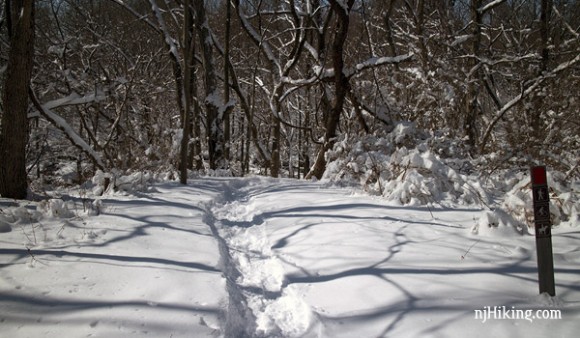
Dress in layers
This is really the key to being outside in cold weather; add and remove pieces as needed.
Don’t overlook packing a hat and gloves even in shoulder-seasons – they offer an easy way to control temperature.
Having a variety of pieces to layer lets you hike comfortably year-round. All but the heaviest of items can be used for multiple seasons. We don’t necessarily wear all of these at once!
Depending on the conditions, use these layers:
- Bottom: Moisture-wicking breathable shirt or thermal layer.
- Mid: Insulating layer like a hoody or fleece jacket.
- Outer: Water/wind proof layer.
- Hat and gloves.
- Good socks; waterproof boots.
Specific models mentioned may be discontinued as gear changes constantly (and we use stuff for a long time), but something similar is usually available. These are our own purchases except for a few Kuhl items.
Related: Snow Forecast and Snow Depth Maps for New Jersey and the Northeast
Bottom Layers:
Long-sleeved wicking tee base layer. Realistically almost any shirt that wicks sweat (i.e. isn’t cotton) will do the trick here, it doesn’t have to be expensive or fancy.
We have several ancient EMS Techwicks that get year-round use on the their own, or over a t-shirt. I have a Smartwool long sleeve base layer I really like (Sport 250, merino blend. It’s warm but thin to fit under everything).
Insulated bottoms. These are skin-tight to be worn under other layers. Generally we fit a base layer bottom under our normal hiking pants and sometimes I’ll use them under a pair of fleece exercise pants.
We have older Under Armour Cold Gear bottoms but even an inexpensive pair of thin tights will add some warmth. Also adding an insulated top is an option to keep the bulk down, but we just layer instead.
See Also: Hiking Pants and Shorts | Hiking Shirts and Layers
Mid Layers:
Lightweight hoody, with thumbholes. Popping up a thin hood up takes the chill right down without being bulky. Thumbholes add extra warmth under gloves or give a bit of warmth without them.
I scooped up a REI Contour Hoody on clearance that I use all the time and Tom uses a lightweight North Face hoody.
Heavyweight 1/4-zip long-sleeved shirt. If my outer layer has a hood I go back to my trusty old Techwick that zips up to my neck.
Outer Layers:
This depends on the temperature and how much activity we’re doing. We might use two mid-level pieces instead. Look for jackets with “pit zips” – zippered openings under arms to vent heat without needing to remove the jacket.
Jacket/Fleece. This layer can get a lot of use and you might want a couple of different pieces.
I use an Under Armour Reactor (mid-weight; discontinued) or an ancient REI-branded basic fleece while Tom uses a Kuhl Interceptr full-zip (review).
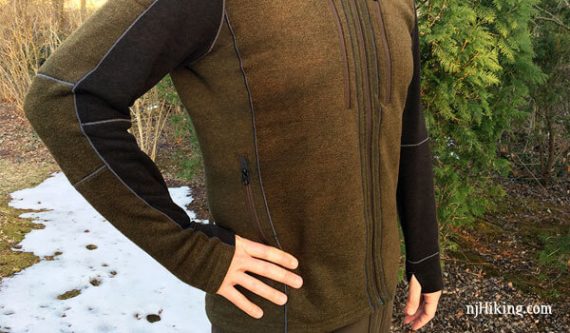
Vest. A lightweight puffy vest is a versatile layering piece, adding just a bit more warmth when you need it and packing away when you don’t. I like my Nano Puff but any vest will do.
Heavy jacket. For when it’s really cold or snowshoeing. Keep in mind your activity level as it’s easy to heat up once you get going. We often just use another layer and not a heavier jacket.
Some jackets have handy “pit zips” – zippered openings under arms to vent heat without needing to remove the jacket.
We both like Kuhl’s Spyfire (Men’s Spyfire Jacket / Women’s Spyfire Hoody). These are super lightweight but warm, and it looks nice so it does double-duty as an everyday coat too. For years Tom used a Columbia Vertex w/zip-out lining which was nice but much bulkier.
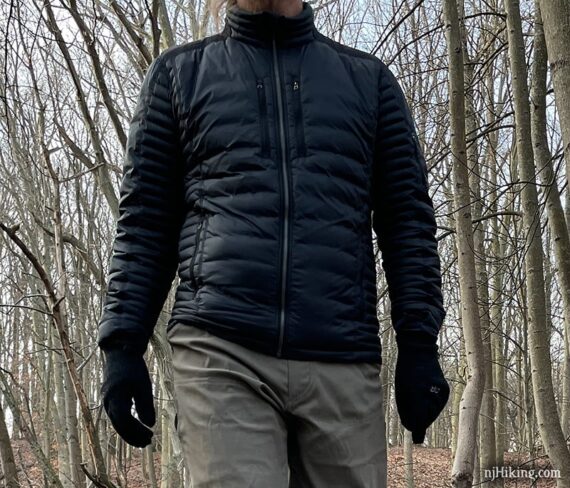
Rain / Wind Protection. It’s worthwhile to pick up a basic packable lightweight rain jacket or windbreaker (fits into it’s own pocket or a stuff sack).
We’ve been using basic inexpensive packable rain jackets from EMS that we got ages ago. We look like rumpled messes when we wear them but they have saved the day more than once.
We do have more substantial gear for trips as we generally don’t go hiking in the rain in Jersey… at least not intentionally.
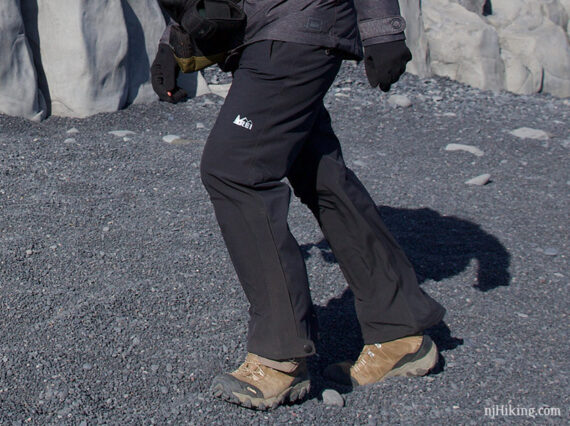
Tom uses Marmot Precips rain pants and I use REI’s Talusphere pants (shown above; now discontinued but their Flash Stretch Rain Pants look similar ).
These easily pull on over hiking pants and the material is soft/stretchy and different that swishy rain pants. I’ve gotten a LOT of use out of the Talusphere – rain, wind, warm layer, snowshoeing.
Soft Shell Pant. Rugged, water, and wind resistant pants for cold/wet weather and snowshoeing. These are dedicated pants and not pullovers like rain or wind pants. Tom likes Kuhl’s Transcendr and I have a Klash soft shell pant (review).
See Also: Kuhl’s Renegade Pant | Kuhl’s Konfidant Air Pant | Kuhl’s Klash Pant | Kuhl’s Interceptr Jacket
Head & Feet:
Gloves: Basic lightweight ones, and heavier for really cold weather. Look for touchscreen capable as well as grippy areas to hold onto your phone while snapping pics.
Hat: Lightweight fleece beanie hat; heavier knit hats; Peruvian-style (wool with ear flaps). Tom likes the classic “Alf” hat.
Polar Buff headwear. Tube of fabric with fleece on one half, and lighter fabric on the other that can be configured into hat, neck gaiter, balaclava, etc.
Socks: We lean towards Darn Tough, Smartwool, Wright Socks, Worn Brand. We use the same hiking socks year round and don’t buy anything winter specific.
Boots: We both use a Mid-cut Oboz. These aren’t winter specific but we haven’t found we need a dedicated winter boot.
Related: Gifts for Hikers | Hiking Clothing | Hiking Footwear
Resist the temptation to dress too warmly.
When you are shivering at the trailhead, you may think you need heavier stuff than you really do.
You may be chilly for the first 15 minutes, but once you get moving you will warm up quickly. And if you will be doing a lot of uphill, you will heat up more than level hiking.
We generally only wear a heavier coat when it’s very frigid or snowing, or it’s cold and we’re on an easier hike where we’re not exerting as much.
Hypothermia.
If you heat up too much and start sweating, you can risk hypothermia. It can be tough to get the balance right but adjust your temperature by adding/removing hat and gloves, and opening/closing pit zips or other clothing vents.
With layers, you can remove a piece to cool down and dry out some, then put it back on.
Another way to mitigate sweating is to slow your speed, or at least taper your speed down as you approach a stopping point. (See, “How to Layer for Winter” from AMC).
Tip for chilly starts: If you tend to run cold and always find yourself shivering for the first 15 minutes of a hike… try jogging in place for a few seconds at the trail head, or do a couple of jumping jacks to kick start your body a bit.
Yes, you’ll look stupid. But you won’t be cold.
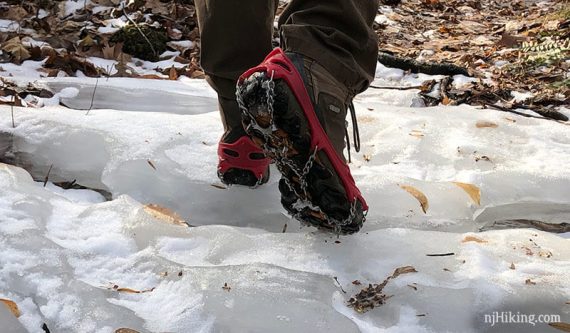
Traction Aids/Winter Gear
MICROspikes or YakTrax
Super helpful for traction on ice and compacted snow, these upped our winter hiking a LOT when we started using them years ago. With MICROspikes it’s possible to just walk normally on a solid icy trail.
In very icy conditions Crampons may be better.
Related: MICROspikes and YakTrax comparison: Hiking Traction Devices.
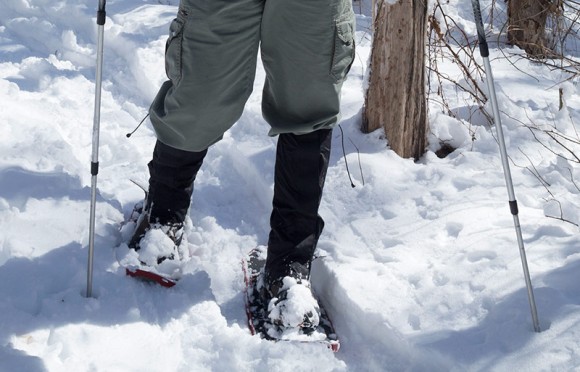
Snowshoes
Snowshoeing is a fun way for the whole family to explore outside in the winter. Unlike other snow sports that require a certain amount of skill, nearly everyone can snowshoe.
It’s important to get the proper snowshoe for your weight, use, and for gals to get a women-specific model (gals and guys have different gaits).
Not ready to buy? Some gear shops, ski areas, and local parks offer rentals.
Related: Snowshoe buying guide.
Gaiters
Can be worn around the lower leg and over boots to keep deeper snow out and pants from getting wet.
Ones for snow are water repellant and usually go up above the calf. There are other lower models that are meant more for sandy/desert conditions.
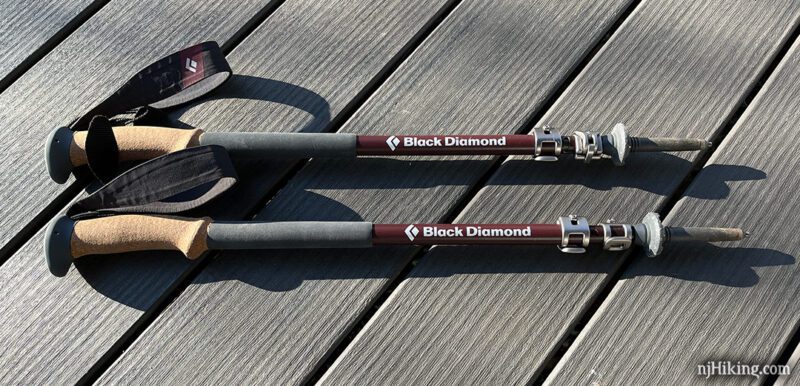
Trekking Poles
These add stability in slippery conditions. Even if you don’t normally use them, you may want them for hiking in snow or ice. Very helpful with snowshoes.
Related: Trekking Pole Reviews.
Bonus uses for winter gear:
In case you need to justify the purchase….
YakTrax: great for dog walking and snow shoveling.
Gaiters: For deep snowfalls, we wear ours to shovel out the driveway. Our neighbors are jealous of our snazzy leg gear (…or think we are crazy…it’s a toss up…)
Tips:
Pack a headlamp. Daylight hours are limited; know when sunset is. Start early and pack a headlamp in case you get caught out in darkness.
Headlamps are inexpensive and are hands-free unlike a flashlight. A smartphone as a flashlight works but don’t rely on it. We pack Petzl Headlamps that barely weigh anything.
In under 20 degree weather try breathing in through your nose, out through your mouth to warm up the air before it gets into your system.
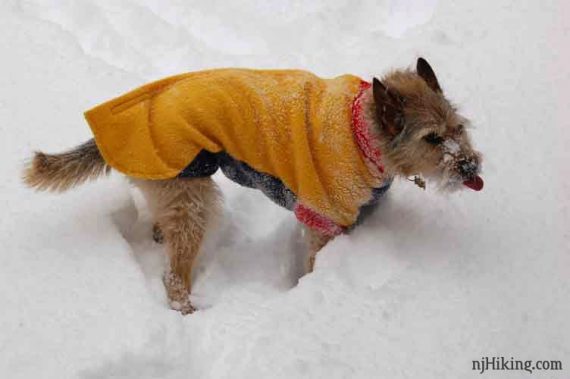
Winter Hiking with Dogs
Keep your furry friend safe and comfortable in the snow. Cold temperatures, snow stuck to fur, salt and de-icers irritating paw pads… what’s a dog to do!
Dog Jackets – Insulated and/or water resistant coats to keep your dog comfortable while enjoying the trail with you. Abrasion/snag resistant and reflective.
Dog Booties – Protect your dog’s paws from injury and irritation from snow buildup, salt and de-icer. Or try Musher’s Secret cream.
Be sure to bring water and snacks for your pup. If it’s hunting season, have something blaze orange on them as well.
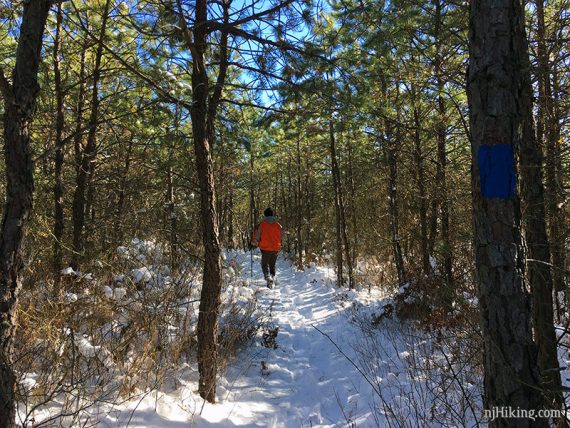
Winter Hiking in New Jersey
New Jersey gets varying amounts of snowfall.
Northern Jersey usually gets the most and may have deeper snow and more ice than central or southern NJ. (Regions loosely based on dividing the state in thirds).
The Northwest corner – Sussex and often Warren counties – generally gets the deepest snow. The higher areas of North Central (like West Milford) tend to get more as well.
Keep that in mind when choosing where to hike in the winter.
Central NJ may have no snow on the ground for weeks, or not have gotten any snowfall but we’ve headed north to a park only to find several inches of compacted, icy snow we weren’t prepared for.
Now we always chuck our MICROspikes in our winter get-out-and-go duffel, just in case.
If it’s snowed a lot and we don’t feel like tramping through it, we head to south Jersey where they usually have less or no snow.
Usually. There have been occasions where South Jersey is sitting under a bunch of snow and there’s not a snowflake on the ground in the North.
Trail surface is a consideration as well.
Northern New Jersey is rockier, with more elevation changes to negotiate in snowy or icy conditions. For experienced hikers looking for a challenge, this is where you’ll want to go.
Central New Jersey trails often incorporate field edges which makes them a good choice for snowy hiking or snowshoeing – but those open areas aren’t ideal in windy conditions.
For easier trails, head to southern New Jersey and especially the Pinelands. The flat trails there are fantastic for winter hiking or snowshoeing.
Bonus: The Pinelands stay green year round and can be a welcome change to the leafless brown trees elsewhere.